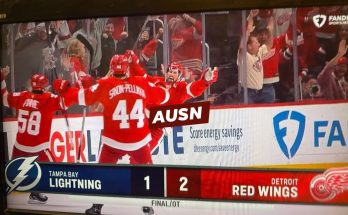The New York Rangers have turned heads across the NHL with a series of bold trade moves, sparking intense buzz among fans and analysts alike.
The New York Rangers have turned heads across the NHL with a series of bold trade moves, sparking intense buzz among fans and analysts alike. In a league where timing and precision often determine a team’s trajectory for years to come, the Rangers have embraced an aggressive approach that signals their intent to compete at the highest level. These moves haven’t just been about filling gaps—they’ve been calculated steps toward building a roster capable of contending deep into the playoffs and, ultimately, hoisting the Stanley Cup. For a franchise steeped in history and driven by the hunger for another championship, this flurry of activity has set the hockey world abuzz and injected a fresh sense of urgency into their campaign.
At the heart of these moves lies a clear message: the Rangers are all-in. From acquiring established stars to offloading contracts that no longer aligned with their long-term vision, the team’s front office has been proactive in crafting a roster that balances elite skill, physicality, and depth. For years, critics have debated whether the Rangers were a true contender or merely a team with flashes of brilliance, but this latest series of trades seems to silence those doubts. They’re not just building for the future—they’re gunning for the present. Every decision has been strategic, each transaction made with the understanding that opportunities in the NHL are fleeting and that windows to win championships can close as quickly as they open.
One of the most notable aspects of these recent moves has been the Rangers’ willingness to part ways with young talent and draft capital to bring in proven performers. While this approach carries inherent risks, particularly in a salary-cap era where future flexibility is precious, the Rangers have decided that the time to win is now. They’ve identified the core pieces of their team—players like Artemi Panarin, Adam Fox, Igor Shesterkin, and Mika Zibanejad—as foundational pillars and have built around them with complementary skill sets. By targeting players who can immediately make an impact in key areas such as scoring depth, defensive stability, and special teams, the Rangers have created a roster that feels far more complete than in previous seasons.
The excitement surrounding these trades isn’t limited to the on-ice implications; it also reflects the boldness of the Rangers’ front office. In an era where many teams operate with caution, fearful of making a move that could backfire, the Rangers have embraced an assertive philosophy that aligns with the ambitions of their fan base. New York is a market that demands success and thrives on high-stakes drama, and these trades have delivered exactly that. Fans who packed Madison Square Garden last season left with a mix of hope and frustration—hope because of the undeniable talent on the roster, and frustration because the pieces didn’t quite click when it mattered most. These moves are designed to erase that frustration and transform hope into confidence.
Analyzing the specifics of these trades reveals a common thread: versatility and playoff readiness. The Rangers have targeted players who bring not only skill but also the grit and experience required to navigate the grueling postseason. NHL playoffs are an entirely different animal compared to the regular season—games tighten, space disappears, and every shift is a battle. The Rangers’ front office appears acutely aware of this reality, adding players who excel in those high-pressure situations. Whether it’s a forward who can dominate the faceoff circle, a defenseman with a knack for shutting down top lines, or a winger who brings a heavy forecheck and net-front presence, the Rangers have checked multiple boxes with these acquisitions.
Of course, bold moves invite scrutiny. Some analysts question whether the Rangers have mortgaged too much of their future, pointing to the loss of promising prospects and valuable draft picks. In the NHL, where parity reigns and unexpected contenders emerge every season, there’s always a degree of uncertainty when sacrificing long-term assets for short-term gain. Yet, the Rangers’ calculation seems rooted in a simple truth: elite goaltending and a strong core do not guarantee unlimited chances. Igor Shesterkin, one of the best goaltenders in the world, is in his prime, and players like Panarin and Zibanejad remain at the peak of their powers. Waiting for prospects to develop could mean missing the current window, and the Rangers have shown they’re unwilling to take that risk.
The immediate reaction from fans has been a mix of exhilaration and curiosity. Social media has exploded with discussions, debates, and predictions about how these moves will translate once the puck drops. Many supporters applaud the aggressiveness, viewing it as a refreshing change from the cautious approach that sometimes plagues big-market teams afraid of negative headlines. Others, however, adopt a wait-and-see attitude, acknowledging that while the roster looks formidable on paper, championships are not won through transactions alone. Chemistry, health, and timely performances will ultimately determine whether these trades achieve their intended goal.
Another fascinating dimension of this story is how it reshapes the Rangers’ identity. For years, the team has been associated with skill and speed, often leaning on finesse to win games. These latest acquisitions add a layer of toughness and resilience that has sometimes been lacking. In a Metropolitan Division stacked with physical teams, that edge could prove decisive. Playoff series often hinge on battles along the boards, in front of the net, and in the corners—areas where the Rangers have occasionally been outmuscled. By addressing those deficiencies without sacrificing their hallmark skill, the Rangers have positioned themselves as one of the most balanced teams in the league.
Coaches now face the enviable challenge of blending these new pieces into the existing framework. Integrating talent mid-season can be tricky, as it requires adjustments to systems, line combinations, and special teams units. However, the players acquired by the Rangers are seasoned professionals accustomed to adapting quickly. Their experience should smooth the transition, allowing the team to maintain momentum while fine-tuning its approach. Success will depend on how quickly chemistry develops, particularly in the top six forward group and among defensive pairings. The Rangers’ coaching staff understands the urgency and will likely experiment in the short term to identify optimal combinations.
The ripple effect of these trades extends beyond New York. Rival teams in the Eastern Conference have taken notice, recognizing that the Rangers are serious about challenging for supremacy. This could trigger a domino effect, prompting other contenders to make their own moves to keep pace. In this sense, the Rangers have not only altered their own trajectory but also influenced the dynamics of the entire conference. It’s a classic case of one team’s boldness reshaping the competitive landscape, and it adds an extra layer of intrigue as the trade deadline approaches.
Looking ahead, the question is not whether the Rangers have improved—they undoubtedly have—but whether the upgrades will be enough to achieve the ultimate prize. Stanley Cup contention requires more than talent; it demands resilience, adaptability, and a little bit of luck. Injuries can derail even the most well-constructed teams, and hot goaltending on the opposing side can nullify the best-laid plans. Still, the Rangers have given themselves every possible advantage by addressing weaknesses and fortifying strengths. They’ve embraced the philosophy that fortune favors the bold, and in doing so, they’ve reignited the passion of a fan base that craves nothing less than a championship parade down Broadway.
What makes this moment particularly compelling is the sense that the Rangers are not just making moves for the sake of making moves—they’re executing a vision. This is a franchise that has navigated the highs and lows of rebuilds, retools, and near-misses. The scars of past disappointments linger, but they also fuel a determination to get it right this time. Every player brought in represents a piece of a larger puzzle, one designed to withstand the pressures of playoff hockey and emerge victorious. That clarity of purpose resonates with fans and sets the stage for what could be one of the most thrilling chapters in recent Rangers history.
If these trades pay off, the narrative will shift from bold gambles to masterstrokes of roster construction. The architects of this strategy will be lauded for their foresight and courage, and the players will have the chance to etch their names alongside the legends who have worn the iconic blue sweater. If not, the second-guessing will be relentless, and the price paid in prospects and picks will become a focal point of criticism. Such is the nature of high-stakes decision-making in professional sports—a reality the Rangers have embraced with eyes wide open.
For now, optimism reigns. The Rangers have declared their intentions in unmistakable fashion, and the hockey world is watching closely. Every pass, every goal, every save in the coming months will carry added weight, filtered through the lens of these blockbuster moves. The margin for error may be slim, but the potential rewards are enormous. In a city that thrives on drama and demands excellence, the stage is set for a captivating journey—one that could end in triumph or heartbreak, but will undoubtedly keep fans on the edge of their seats every step of the way.



